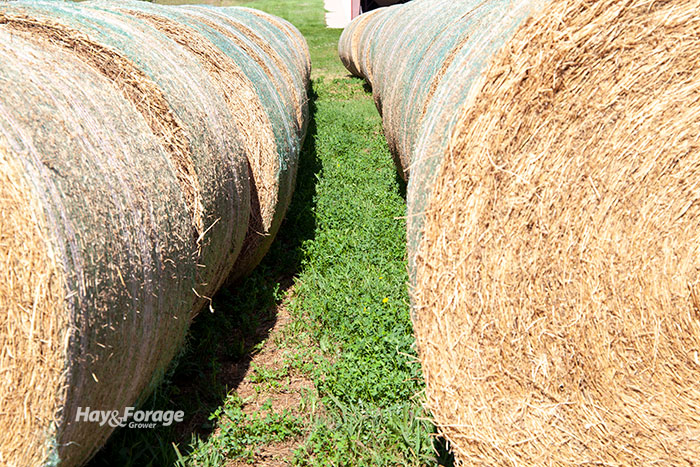No hay barn – maybe no problem |
| By Amber Friedrichsen, Associate Editor |
|
|
 When forage production is at a standstill because of the summer heat or winter cold, large round bales can be utilized as feed. However, unrolling these bales and finding significant amounts of feed waste can be frustrating and is often the result of improper storage. Bales stored outside without protection are the most susceptible to damage. Extension specialists Dale Blasi and Jaymelynn Farney with Kansas State University note that these bales can incur feed waste up to 25%. This is because weathering that occurs within the first few inches of the bale’s exterior can impact a large percent of its total volume. “Many producers do not recognize that with a 6-foot diameter large round bale, one-third of the weight of the bale can be found in the outer 6 inches, and 50% of the volume is in the outer 12 inches,” the specialists explain. Covering bales can alleviate some of this loss, whereas storing them in a barn will prevent it even more. This isn’t always an option, though, so Blasi and Farney offer the following advice to maintain the quality of bales kept outdoors. The do’s Consider the type of hay being baled. Grass hays have a lower risk of suffering weather-induced losses than stemmy hays, such as alfalfa and mature small grains. Finer-stemmed hays are also easier to bale at a high density, which is advantageous for storage. “A dense bale will sag less, have less surface area in contact with the ground, shed more precipitation, and make more efficient use of the bale wrap deployed,” Blasi and Farney assert. “As a rule of thumb, the density of large round bales should be a minimum of 10 pounds of hay per cubic foot.” When bales have been made, line them up end-to-end, packing them together tightly. This not only makes the best use of storage space, but also protects the ends from penetrating rain. Allow 3 feet of space between rows to promote airflow, and be sure to store bales in a well-drained area. “A gently sloping site with a southern or southeastern exposure is ideal to maximize solar drying and encourage drainage away from the bales,” the specialists describe. “To further reduce wastage on the bottom of the bales, elevate them using old tires, shipping pallets, or store the base on a layer of 3 to 4 inches of crushed rock.” The don’ts Avoid stacking bales in a pyramid formation. It may seem like this strategy will maximize storage space more efficiently than lining bales up end-to-end, but it will likely cause more damage. Dry matter will be lost as a result of trapped moisture and reduced air movement. The extension specialists also advise against storing bales under trees. Some producers move bales to a central location, such as the perimeter of a field, out of convenience. Nevertheless, the trees can encourage degradation by blocking sunlight, hindering the bales’ ability to dry.  Amber Friedrichsen Amber Friedrichsen is serving as the 2021 Hay & Forage Grower editorial intern. She currently attends Iowa State University where she is majoring in agriculture and life sciences education-communications with a minor in agronomy. Friedrichsen grew up on her family’s diversified crop and livestock farm near Clinton, Iowa. |
